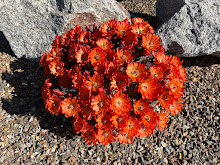I was looking back through my photographs from last year to see when I can expect the Gopher plant, Euphorbia rigida, to start flowering. Or at least looking better than it does now. These photos where taken the middle of February last year, just as they were coming into flower.
But the main reason I was looking back was because I am looking at my plants now and wondering if their life-span has come to an end. They are looking pretty wretched, long and lanky with masses of missing leaves along the length of the stem. Of course that always happens whether from drought in summer or excessive rain at other times. They certainly got a dose of both this year.
In my opinion this plant has two good seasons. The season when it flowers and the season when the new leaves have reached about 12". Then they take off, snaking across the garden. The two good seasons follow each other. First the flowers on the old stems and almost immediately the new growth. If you don't want to collect the seeds after flowering then the stem can be cut back to tidy the plant.
If you are growing this plant for the first time don't be tempted to cut off those lanky stems because if you do you will be cutting off this year's flowers. There may be one or two stems that clearly are not productive but hold fast on the rest.
So what do mine look like now?
Long, lanky, twisted and scarred from a Texas year.
The stems are badly scarred and there are stumps from last years old stems which were not cut off down to the crown. Those can be tidied up by either pulling them or snipping at the base. That's all the new growth at the base and will plump up over the next month, growing longer over the summer until they flower next February.
I am asking myself if I can live with this mess. For the time being I will give the plant the benefit of the doubt and see how it performs this spring. Then it may be a case of starting over again or planting something less untidy for much of the year. We shall see.
Squirrel and Pecan
1 day ago

































6 comments:
I was just looking at my Euphorbia rigida this weekend and thinking they were budding up early. This winter has been so blessedly mild (so far). I stopped growing Euphorbia myrsinites because of that lanky stem thing, thankfully my E. rigida haven't started doing that. Fingers crossed yours will perform!
Your post sent me outside to check the few Euphorbia rigida I have. One, with lanky stems, already has buds, although the other plants I had in that area appear to have disappeared (probably during one of my excessively vigorous clean-up operations). The other three, though in a sunnier area, are more upright but also bud-less. Gardens are sources of endless mysteries.
I can only grow the native Euphorbias...and some of those are weeds! But, I do think these are beauties. Love the green in your garden against the stones!
These are beautiful! I can see why it's hard to look the other way at certain stages, but wow, it's worth it to let them be for those beautiful blooms! The Euphorbias are wonderful--so many fascinating species. I have E. polychroma here, which is such a vibrant late-spring bloomer for us. Last year, I added the native E. corollata to the garden--through seeds and a few transplants from our other property. It will be interesting to see if they make an appearance this next growing season.
Such an interesting plant! That lanky growth would drive me rather nuts too, but that would be sad to not have the pretty flowers that are almost here.
A crevice garden starting from your summer inspirations sounds great. I took Kenton Seth on a hike above my former El Paso neighborhood, showing him wild, mountainside crevice gardens with various desert spikes mid-winter. The geology at my new neighborhood gave me no such luck!
Post a Comment